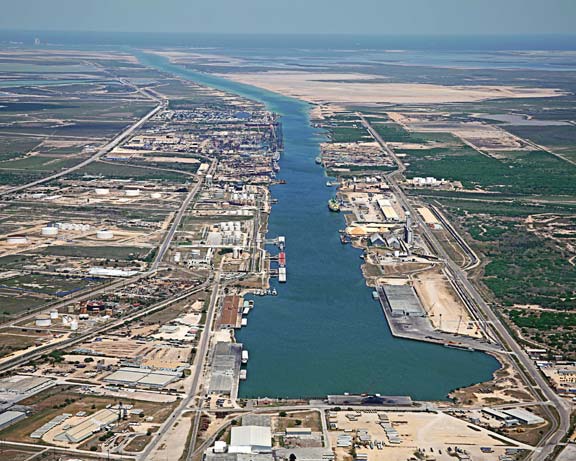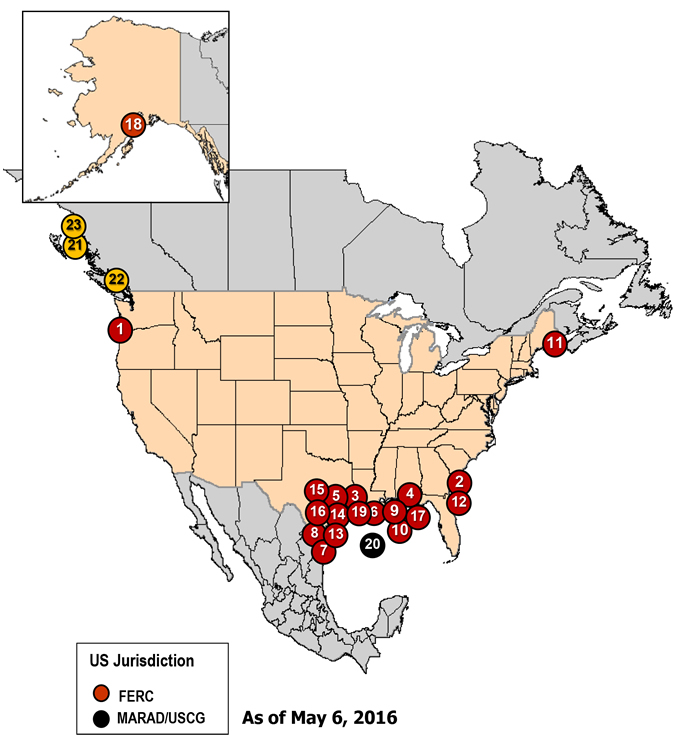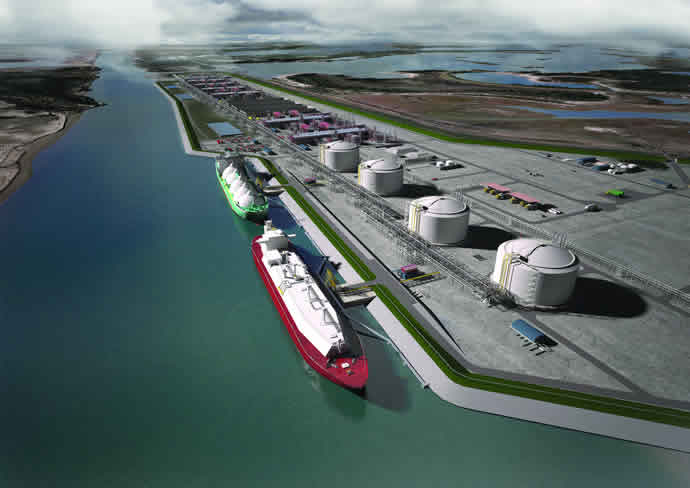The Texas energy economy is down. But it’s by no means out.
A glance at the Federal Energy Regulatory Commission’s most recently updated liquefied natural gas (LNG) map shows you why. Like a cluster of grapes, FERC-approved LNG import and export terminal projects hang off the fertile Gulf Coast from Cheniere in Corpus Christi, Texas, and Sabine, Louisiana; Freeport LNG in Freeport, Texas; Sempra-Cameron LNG in Hackberry, Louisiana; and both Magnolia LNG and Southern Union-Lake Charles LNG in Lake Charles, Louisiana. The Cheniere project in Corpus Christi just sent its first cargo to Brazil.
Those projects — some now oriented toward liquefaction and export after originally being conceptualized as import terminal sites — represent tens of billions of dollars of construction investment, and billions of dollars in global LNG contracts with customers around the world looking to grab some of the bounty from the US shale gas boom.
Add in the group of proposed LNG projects, and the Gulf Coast cluster opportunity is getting juicier by the day.
Last week, LNG development and management company NextDecade, based in The Woodlands, Texas, announced it had filed an application with FERC to site, construct and operate Rio Grande LNG, a proposed 27-Mtpa (million metric tons per year) LNG export facility near Brownsville, Texas and the Rio Bravo Pipeline, a 137-mile pipeline system that will provide the facility with its feed gas, with a view toward a final investment decision in 2017. The complex would be one of the largest LNG export operations in the world, with capacity of 3.6 Bcfd (billion cubic feet per day). It’s expected to create between 4,000 and 6,000 construction jobs, and more than 200 permanent jobs, reflecting a potential investment of up to $20 billion.
“After a productive pre-filing with the FERC and extensive consultation and cooperation with the reviewing agencies and local communities, we are proud to have achieved this major accomplishment,” said Kathleen Eisbrenner, NextDecade’s CEO. “Despite recent low oil and gas prices, we have found robust appetite for U.S. LNG on a long-term basis all around the world.”

Kathleen Eisbrenner, CEO, NextDecade
Brownsville’s recent LNG experience includes the 2012 news that Gulf Coast LNG chose the port for an export terminal expected to attract investment of more than $6 billion. The project filed for an export license from the US Dept. of Energy, but did not enter the FERC pre-filing process. In an interview then, Michael Smith, CEO of both Gulf Coast LNG Export, LLC, and Freeport LNG Development, L.P., said, “There was a site selection process, but the reality is that there is only a very limited number of ports with a deep enough channel that had all the necessary requirements to be an excellent site for an LNG export facility.”
Eisbrenner echoed those sentiments in an exclusive interview with Site Selection in April, saying the Brownsville site came about in part because of an alternative site search the company initiated after it missed an option payment on a site in Corpus Christi and another firm swooped in and bought the Corpus Christi site outright. It was an unfortunate development, but a blessing in disguise, says Eisbrenner, as it “caused us to realize how few appropriate sites there are along the Gulf of Mexico.”
No wonder, then, that others wish to alight in the same spot. Brownsville also is the location for proposed projects from Houston-based Texas LNG Brownsville (which filed its FERC application in March) and Annova LNG Brownsville (backed by Exelon). News reports indicate that early this month Annova agreed to adjust the location of its project in order to protect the habitat of an endangered species of ocelot.
Meanwhile, Gulf Coast LNG stalled out, and saw its lease option expire on January 8, 2016. Another lease option to a project from Latin American concern SEG-Sideco expired on December 16, 2015.
Two more LNG projects (in addition to Gulf Coast LNG) received DOE export licenses but have not initiated the FERC pre-filing process: Eos LNG and Barca LNG, both of them originally designed to be waterborne facilities, are planned for onshore locations at the Port of Brownsville, according to a January 2015 commentary from Eos and Barca CEO Andrew Kunian in The American Oil & Gas Reporter. However, at least one source says those two projects are dormant at the very least.
Even just the three projects in the FERC queue (NextDecade, Annova and Texas LNG), represent a mammoth cumulative investment and construction zone. But the port — the only deepwater seaport directly on the US-Mexico border — appears ready to handle it. More than 10.1 million tons of cargo moved through the port in 2015, exceeding the 2014 record of 8.4 million tons. And it’s the largest land-owning public port authority in the nation, with 40,000 acres (16,188 hectares).
“We have the property to accommodate all three if they are approved,” says Patty Gonzales, director of marketing and PR for the Port of Brownsville. “We’ve identified locations for them. All three have lease options.”
Aligned and In Line
NextDecade also is pursuing the Pelican Island LNG project in Galveston. The firm expects to begin exporting LNG from Rio Grande LNG by the end of 2020.
“I want to thank the entire NextDecade team as well as our valued partners at CB&I, Ecology & Environment, Norton Rose Fulbright, HGA and CH-IV, to name just a few, for their monumental efforts to further advance the Rio Grande LNG project,” said NextDecade Senior Vice President of Development & Regulatory Affairs Shaun Davison at last week’s FERC filing, which began with an initial application filing a year ago.

The Port of Brownsville, which celebrates its 80th anniversary this week, is the chosen site of several proposed LNG export terminals. Archive photo courtesy of Port of Brownsville
Indeed, in an interview with Site Selection in April, Eisbrenner noted how just going through the FERC process is an expensive undertaking all by itself.
“The development process is quite costly,” she said. “It’s expensive to hire the right team, but also the right ancillary members of our team — regulatory engineers, front-end design, environmental consultants, pipeline consultants. It can be up to $100 million to go through the FERC process.”
Fortunately, NextDecade has both the funds and the fortitude to see it through, she said, anticipating this month’s filing. Prior to founding NextDecade in 2010, Eisbrenner served as executive vice president at Royal Dutch Shell, responsible for Shell’s Global LNG strategy where she managed Shell’s global LNG portfolio and was responsible for growing an LNG platform that includes 19 existing LNG trains in six countries, and two additional trains under construction.
“I’ve been involved in a few,” she said, noting her leadership of site selections for facilities in the Gulf of Mexico, offshore Massachusetts, the UK, Kuwait and the UAE. “Every country is quite different. When I moved from building in the US to building in the UK [circa 2006], I found that to be an absolutely fascinating experience.” Unlike the current low natural gas prices in the US incentivizing export, in those days the North Sea gas fields were going into decline.
“So prices switched, and the UK became a much higher-priced natural gas market, and the US lower,” Eisbrenner explained. “So we decided to build an import facility in the UK, and because of the worry of running out of gas, and high prices for their industry, we had incredible support. It was permitted in probably half the time as in the US. It was a surprisingly positive experience.”
Kuwait offered a “completely different set of circumstances,” she said, with a nationalized oil company serving as the counter-party. “It wasn’t an overseen regulatory agency like FERC to deal with, so that made it very efficient also.”
Don’t take that the wrong way though.
“We’ve found the FERC process to be very constructive,” she said. “The nice thing about FERC is you know what you need to do to satisfy FERC and all the agencies that are managed by FERC. In Canada, people like it because they say there isn’t a FERC. That may be good news, but nothing is getting done in Canada because there isn’t a FERC. What it takes to clear hurdles is murky. We’ve built things in the States before, so we know how to do it.”
Eisbrenner’s pioneering ways go beyond those projects, however.
“Prior to joining Shell, Kathleen founded and became CEO of Excelerate Energy, revolutionizing the LNG industry by spearheading and creating the first FSRUs [floating storage and regasification units], in essence floating import facilities,” explains James Markham-Hill, NextDecade’s manager of communications. “This development dramatically altered the LNG-industry landscape as it opened up new markets for LNG. In 2000, there were only 11 LNG-importing countries. In 2005 the first FSRU was completed by Kathleen at Excelerate, followed by many others. By 2010 the number of LNG-importing countries had doubled to 22. This growth can be strongly attributed to the creation and development of the FSRU business that Kathleen built.”
Lessons Learned, Business Earned
Eisbrenner has found the local and regional process in Texas equally constructive, from the US Army Corps of Engineers’ Texas office to the state legislature to the communities of Brownsville and Port Isabel and their ports. And just as an infrastructure of policy guides FERC, a physical and business infrastructure helped guide NextDecade’s location choice for the 1,000-acre site in Brownsville. Access to deep water and large gas reserves were important, of course, but also playing into the equation was the area’s history of successful business development and operations.
“It’s a greenfield plant, but it’s not a greenfield port,” she says. “In Mozambique and Australia and Canada, everything would need to be built from underground up. It’s wonderful working with the Port of Brownsville. They have a history of operations with procedures in place, safety, pilots, the basics we need for a marine-based operation.”
Recent history counts for a lot too, she says. “I think we’ve learned a lot from watching Cheniere and Freeport. Contracting processes is the first thing that comes to mind. They’ve established rules of the road for contracting with international customers, and for how developers can work with EPC [engineering, procurement and construction] contractors to get these very expensive facilities online. I like to describe our project as intending to be the second wave of LNG — we want to take all of those lessons, and apply tried-and-true technology.”

This May 6 update of a FERC map shows the heavy concentration of proposed LNG export terminals along the Gulf Coast. Map courtesy of FERC
Working with fellow Woodlands-based giant CB&I helps where that’s concerned, as NextDecade will be able to leverage the firm’s experience working not only on the Cameron and Freeport LNG projects, but on a project platform similar to NextDecade’s in Peru. Eisbrenner calls the workforce situation in Texas “dramaticallly different than even a year ago, and definitely improved. Talent a year ago was a big concern, frankly,” due to the glut of petrochemical and other projects. But the energy downturn has had a positive impact on the project. Combine that with the fact that CB&I workers on the other two Gulf Coast LNG project will be able to shift to Brownsville in 18 months as those project wind down, and you have an ideal setup for combining well-trained, experienced staff with local talent.
Such leveraging “helps keep our costs low,” she says, “because we’ll be the fourth one. Importantly, it keeps our risks low. A lot of people underestimate how conservative the international LNG customer is: When they make a commitment to sign up for 20 years, it’s not all about price — it’s about making sure all things are going to go well across that time frame, so they can count on that in their portfolio.”
In NextDecade’s case, those customers are across the globe, from Europe to China to the Middle East, as well as traditional customers in Japan and South Korea. In November 2015, NextDecade announced that it had signed non-binding agreements for 14 Mtpa of LNG with customers from across Asia and Europe. Since then, that number has grown to 26 Mtpa. The firm’s team headed to the tri-annual LNG 18 event Perth, Australia, in April to work toward binding commitments with those customers and more.
How Long?
Asked about the ongoing debate over whether exporting natural gas is ultimately a good thingfor US industry, Eisbrenner is willing to weigh in:
“I believe there are virtually unlimited reserves of natural gas available economically in the US,” she says. “Even in robust times, the shale revolution is truly a revolution.It’s turned what used to be an E&P [exploration and production] business into a manufacturing business.
“The manufacturers who used to worry about these things, if they were rationally looking at the situation today, would have to admit that shale production is a manufacturing process like a chemical plant is,” Eisbrenner contends. “They’re going to operate commercially, in their own best interests, but also in the interests of their customers. What has enhanced that situation is this downturn, because it’s forcing these natural gas producers to focus on getting costs down and getting efficiencies up. We’re operating at record levels of production at well under $2 per BTU. There is plenty for domestic consumption, manufacturing consumption and export.
An IHS report on the economic impacts of shale gas estimates that for every 1 billion cubic feet per day of shale gas production, approximately 32,000 total jobs are supported throughout the economy.
Eisbrenner says she’s had a recent insight about the energy sector’s ebbs and flows:
“Houston is kind of a depressing area to be in right now,” she admits, with low prices persisting and more than 50 bankruptcies so far, with more to come due to high levels of leverage. “But if you see your way through that” by going through the bankruptcy proces and eliminating or restructuring debt, companies can come out more efficient than they were going in. “With their restructured capitalization, efficiencies should only increase, and the potential for prices changing should be pushed down. There’s no other place in the world where gas can be manufactured as inexpensively as we can in this state.”
That doesn’t mean she hasn’t stopped looking. The firm is in final negotiations for another huge US site, offering further ballast for betting on American energy.
“I don’t think there will be LNG development outside the US for at least five years,” Eisbrenner says, “maybe longer.”

Construction of the Rio Grande LNG facility and the pipeline is expected to create roughly 6,000 direct jobs with additional permanent jobs at the facility expected to exceed 200. Artist’s rendering courtesy of NextDecade
 Adam Bruns has served as managing editor of Site Selection magazine since February 2002. In the course of reporting hundreds of stories for Site Selection, Adam has visited companies and communities around the globe. A St. Louis native who grew up in the Kansas City suburbs, Adam is a 1986 alumnus of Knox College, and resided in Chicago; Midcoast Maine; Savannah, Georgia; and Lexington, Kentucky, before settling in the Greater Atlanta community of Peachtree Corners, where he lives with his wife and daughter.xxx
Adam Bruns has served as managing editor of Site Selection magazine since February 2002. In the course of reporting hundreds of stories for Site Selection, Adam has visited companies and communities around the globe. A St. Louis native who grew up in the Kansas City suburbs, Adam is a 1986 alumnus of Knox College, and resided in Chicago; Midcoast Maine; Savannah, Georgia; and Lexington, Kentucky, before settling in the Greater Atlanta community of Peachtree Corners, where he lives with his wife and daughter.xxx







